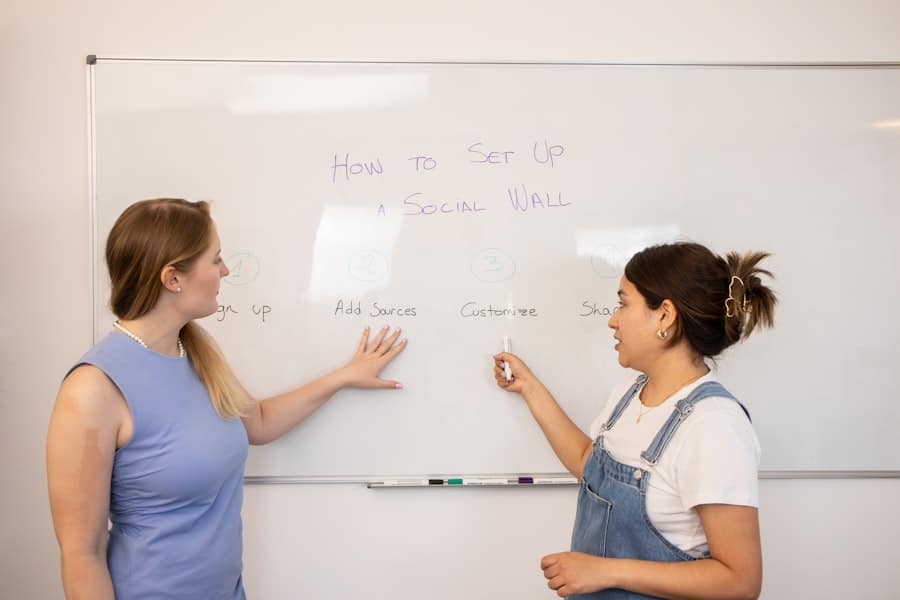Peer-to-peer learning is an educational approach that emphasizes the exchange of knowledge and skills among individuals at similar levels of understanding. This method fosters a collaborative environment where learners can engage with one another, share insights, and develop a deeper comprehension of the subject matter. Unlike traditional teacher-centered models, peer-to-peer learning encourages active participation, critical thinking, and the development of interpersonal skills.
It is rooted in the belief that individuals can learn effectively from one another, leveraging their unique experiences and perspectives to enhance the learning process. The concept of peer-to-peer learning is not new; it has been utilized in various forms throughout history. From study groups in academic settings to informal knowledge-sharing among colleagues in professional environments, the principles remain consistent.
The effectiveness of this approach lies in its ability to create a supportive community where learners feel comfortable asking questions, making mistakes, and exploring new ideas. This dynamic interaction not only enriches the learning experience but also fosters a sense of belonging and motivation among participants.
Key Takeaways
- Peer-to-peer learning is a collaborative approach where individuals learn from each other, sharing knowledge and experiences.
- Digital platforms have revolutionized peer-to-peer learning, providing easy access to a wide range of resources and connecting learners from around the world.
- The benefits of peer-to-peer learning through digital platforms include increased engagement, personalized learning, and the development of critical thinking and communication skills.
- Challenges in peer-to-peer learning, such as lack of structure and potential for misinformation, can be addressed through clear guidelines, moderation, and verification processes.
- Best practices for facilitating peer-to-peer learning online include creating a supportive and inclusive environment, providing clear objectives, and leveraging technology for interactive and engaging experiences.
The Rise of Digital Platforms for Peer-to-Peer Learning
In recent years, the proliferation of digital platforms has transformed the landscape of peer-to-peer learning. With the advent of technology, learners can now connect with peers across geographical boundaries, creating a global network of knowledge exchange. Online forums, social media groups, and dedicated educational platforms have emerged as popular venues for individuals seeking to share their expertise and learn from others.
This shift has democratized access to information, allowing anyone with an internet connection to participate in collaborative learning experiences. Digital platforms have also introduced innovative features that enhance peer-to-peer learning. For instance, many platforms incorporate multimedia resources such as videos, podcasts, and interactive quizzes that cater to diverse learning styles.
Additionally, real-time communication tools like chat rooms and video conferencing enable learners to engage in discussions and collaborate on projects seamlessly. As a result, these platforms not only facilitate knowledge sharing but also foster a sense of community among users, making learning more engaging and enjoyable.
Benefits of Peer-to-Peer Learning Through Digital Platforms

The benefits of peer-to-peer learning through digital platforms are manifold. One significant advantage is the flexibility it offers. Learners can access resources and connect with peers at their convenience, allowing them to tailor their learning experiences to fit their schedules and preferences.
This flexibility is particularly beneficial for adult learners who may have work or family commitments that limit their availability for traditional classroom settings. Moreover, peer-to-peer learning promotes deeper understanding through active engagement. When learners explain concepts to one another or collaborate on problem-solving tasks, they reinforce their own knowledge while helping others grasp challenging material.
This reciprocal teaching approach not only solidifies individual understanding but also cultivates critical thinking skills as learners navigate different perspectives and approaches to problem-solving. Furthermore, the diverse backgrounds and experiences of participants enrich discussions, leading to a more comprehensive exploration of topics.
Challenges and Solutions in Peer-to-Peer Learning
Despite its numerous advantages, peer-to-peer learning through digital platforms is not without challenges. One common issue is the potential for misinformation or lack of depth in discussions. Since participants may have varying levels of expertise, there is a risk that less knowledgeable individuals could inadvertently spread incorrect information or oversimplify complex topics.
To mitigate this risk, it is essential for platforms to implement mechanisms that encourage fact-checking and promote credible sources. Moderation by knowledgeable facilitators can also help guide discussions and ensure that accurate information prevails. Another challenge is the potential for unequal participation among learners.
Some individuals may dominate discussions while others remain passive, leading to an imbalanced exchange of ideas.
Additionally, incorporating collaborative projects that require input from all participants can foster a sense of accountability and encourage active engagement from everyone involved.
Best Practices for Facilitating Peer-to-Peer Learning Online
To maximize the effectiveness of peer-to-peer learning online, certain best practices should be adopted by facilitators and platform designers alike. First and foremost, creating a welcoming and inclusive environment is crucial. This can be achieved by establishing clear guidelines for respectful communication and encouraging participants to share their backgrounds and experiences.
When learners feel valued and respected, they are more likely to engage actively in discussions. Another best practice involves setting clear objectives for each learning session or activity. By outlining specific goals, participants can focus their efforts on achieving tangible outcomes, whether it be mastering a particular skill or completing a collaborative project.
Additionally, incorporating diverse instructional strategies—such as group discussions, case studies, and hands-on activities—can cater to different learning styles and keep participants engaged throughout the process.
The Role of Technology in Enhancing Peer-to-Peer Learning

Technology plays a pivotal role in enhancing peer-to-peer learning by providing tools that facilitate communication, collaboration, and resource sharing. Learning management systems (LMS) have become increasingly sophisticated, offering features such as discussion boards, file sharing capabilities, and integrated assessment tools that streamline the learning experience. These systems allow learners to interact with one another asynchronously or synchronously, accommodating various schedules and preferences.
Moreover, emerging technologies such as artificial intelligence (AI) and machine learning are beginning to shape the future of peer-to-peer learning. AI-driven platforms can analyze user interactions and preferences to provide personalized recommendations for resources or potential collaborators based on shared interests or complementary skills. This level of customization enhances the relevance of the learning experience and encourages deeper engagement among participants.
Case Studies: Successful Peer-to-Peer Learning on Digital Platforms
Several case studies illustrate the successful implementation of peer-to-peer learning on digital platforms across various fields. One notable example is the online coding community Codecademy, which allows users to learn programming languages through interactive exercises and peer support forums. Users can ask questions, share solutions, and collaborate on projects within a vibrant community of learners.
This platform not only provides structured lessons but also fosters an environment where learners can help one another troubleshoot coding challenges. Another compelling case study is Duolingo, a language-learning app that incorporates gamification elements to encourage peer interaction. Users can engage in language practice with one another through chat features and discussion boards while competing in friendly challenges that promote motivation and accountability.
The app’s design encourages users to support each other’s language acquisition journeys by sharing tips and resources, exemplifying how peer-to-peer learning can thrive in a digital context.
The Future of Peer-to-Peer Learning in the Digital Age
As technology continues to evolve, the future of peer-to-peer learning appears promising. The integration of virtual reality (VR) and augmented reality (AR) into educational platforms holds the potential to create immersive learning experiences that transcend traditional boundaries. For instance, VR simulations could allow learners to collaborate on complex projects in virtual environments, enhancing their understanding through experiential learning.
Furthermore, as artificial intelligence becomes more sophisticated, personalized learning experiences will likely become more prevalent. AI could facilitate tailored peer matching based on individual strengths and weaknesses, ensuring that learners are paired with peers who complement their skills effectively.
In conclusion, peer-to-peer learning has emerged as a powerful educational approach that leverages technology to facilitate knowledge exchange among individuals. As digital platforms continue to evolve and adapt to the needs of learners, the potential for collaborative learning experiences will only expand, paving the way for innovative educational practices in the digital age.
In the realm of digital education, peer-to-peer learning has emerged as a transformative approach, leveraging technology to enhance collaborative learning experiences. An article that complements the insights from “Exploring Peer-to-Peer Learning Through Digital Platforms” is the piece on the Galaxy Book2 Pro 360. This article delves into the capabilities of the Galaxy Book2 Pro 360, a device that can significantly enhance digital learning environments. With its advanced features, such as a 360-degree hinge and robust performance, the Galaxy Book2 Pro 360 provides an ideal platform for students and educators to engage in dynamic, interactive learning sessions, thereby facilitating effective peer-to-peer learning experiences.
FAQs
What is peer-to-peer learning?
Peer-to-peer learning is a form of learning that occurs between equals, often taking place in informal settings. It involves individuals learning from and with each other, sharing knowledge, and collaborating to achieve common learning goals.
What are digital platforms for peer-to-peer learning?
Digital platforms for peer-to-peer learning are online tools and resources that facilitate the exchange of knowledge and skills among individuals. These platforms can include online forums, social media groups, video conferencing tools, and learning management systems.
How do digital platforms support peer-to-peer learning?
Digital platforms support peer-to-peer learning by providing a space for individuals to connect, communicate, and collaborate with each other. They offer features such as discussion forums, file sharing, and video conferencing that enable learners to engage in meaningful interactions and share their expertise.
What are the benefits of peer-to-peer learning through digital platforms?
Some benefits of peer-to-peer learning through digital platforms include increased access to diverse perspectives and expertise, opportunities for personalized learning, and the ability to engage in collaborative problem-solving and knowledge sharing. Additionally, digital platforms can provide flexibility and convenience for learners to participate in peer-to-peer interactions.
What are some examples of digital platforms for peer-to-peer learning?
Examples of digital platforms for peer-to-peer learning include online learning communities, such as Coursera and Udemy, social media groups and forums, like LinkedIn groups and Reddit communities, and collaborative tools, such as Google Drive and Zoom. These platforms offer various features to support peer-to-peer learning interactions.

